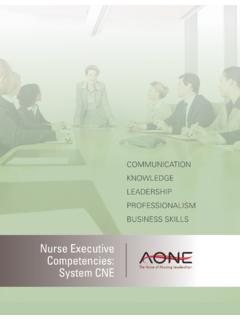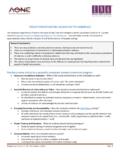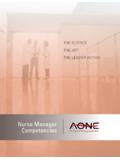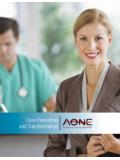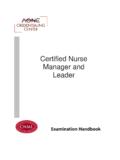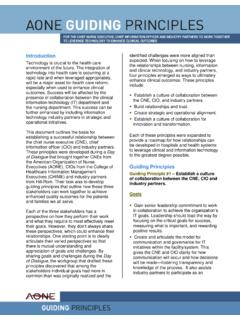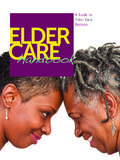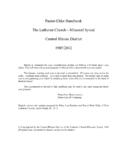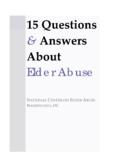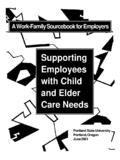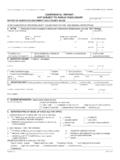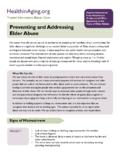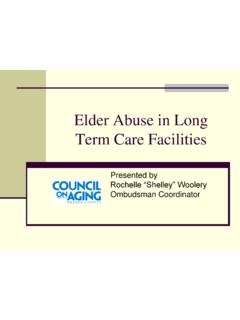Transcription of AONE GuidinG PriNciPlEs
1 aone GuidinG PriNciPlEsGuidinG PriNciPlEs1 AssumptionsCare is moving from patient-centered to patient-driven. Transforming Care at the Bedside (TCAB) PriNciPlEs are applied in process and service improvement initiatives. Quality models are the reference point for measuring and evaluating outcomes. The nurse leader is knowledgeable in the GuidinG PriNciPlEs of elder friendly hospitals/facilities. The chief nurse executive and the nurse manager both support and advance the concepts of the GuidinG PriNciPlEs . The nurse leader represents the value of this work and advocates in all areas of influence. The chief nurse executive and the nurse manager demonstrate transformational leadership skills and characteristics. How those skills and characteristics are applied may be different for each environment.
2 Shared decision-making occurs at all GuidinG PrinciplesFor the PatientEach patient is a unique individual and should be evaluated as care of the older adult takes into account many variables that contribute to a robust plan of care. These include: An assessment process that evaluates chronological and biological age. Risk assessments that are biological/developmental/physiologically based. Recognition of what is going on outside of the acute care setting, such as where the patient lives and their relationship with their family. The creation of an elder journey plan to help individuals navigate the health care system. A perspective of the patient s baseline of where they are at admission and where they want to be at the Nurse ExecutiveA systems analysis of the needs across the organization is done to ensure those assessments take place, and that tools have been created to ensure a system-wide view of needs to ensure each patient is assessed appropriately and their journey plan can be the Nurse ManagerParticipate and influence in the development and implementation of assessment tools by including staff, patient, and family are taken to accommodate the patient and family s special needs.
3 The vision/mission statement of the facility states the commitment to addressing the special needs of older patients and families. The rights of the elderly are assured with an Elder Patient Bill of Rights. There is a broader definition of family that can embrace the diversity of family composition of the older adult. Older adults are reflected in the marketing and promotional materials used by the the Nurse ExecutiveCreate a culture that respects the patient s needs; assure there is a cultural vision that incorporates diversity which includes age and can measure/evaluate the outcome of having met the needs (customer service surveying, Hospital Consumer Assessment of Healthcare Providers and Systems [HCAHPS]).For the Nurse ManagerCreate a culture that respects the patient s needs; assure there is a cultural vision that incorporates diversity which includes age and family at the unit THE ELDEr-frIENDLY HoSPITAL/fACILITY AND THE roLE of THE NUrSE LEADErGuidinG PriNciPlEs2 For the StaffNurses demonstrate clinical competence in geriatric nursing.
4 The NICHE (Nurses Improving the Care of Health-System Elders) clinical competence standards are used for all staff caring for the older patient. Certification in Geriatric Nursing is encouraged and provide therapeutic response, patience and presence when caring for geriatric and staff who provide direct care identify and address the patient s individual needs and preferences. Staff creates a positive experience for the patient and family. Nurses are knowledgeable regarding the resources necessary to provide the geriatric patient with their individual care needs. Evidence-based protocols and assessments are used by every discipline that provides care. Patient care is evaluated in relationship to the patient, family and nurses satisfaction. Geriatric experts are available in other disciplines and coordinate care across the continuum and manage the journey of the patient and family.
5 There is a defined process for the nurse caring for a patient and family that assures that the patient s journey through the health care experience is managed and coordinated. The nurse takes responsibility and accountability for the patient and family s experience by managing the partnership and serving as advocate and broker for the hand-offs to other disciplines/ communication, tailored to meet the needs of the geriatric patient, results in a climate of confidence for the patient and the nurse. Communication competence is measured by the NICHE communication skill lists. Older adults and families participate in directing the care and both feel secure and safe. Educational materials are usable/friendly/responsive to the needs of the older organization provides appropriate resources and systems that support best practice in geriatric nursing care.
6 NICHE identifies the following resources and system characteristics: yEvidence-based tools yContinuing education and certification yWorkforce training in the care of the older patient yVolunteer programs yQuality of life programs ( , therapeutic activities and social support systems) yMeasurement tools and processes that capture appropriate metrics yInterdisciplinary processes for planning yInvolving all stakeholders in institutional decision-making regarding the care of older adultsFor the Nurse ExecutiveNICHE competencies are integrated into performance standards, education and evaluations as appropriate for the staff that care for the elderly models of care used in the institution that support the ability and capacity to implement the For the Staff PriNciPlEs . For the Nurse ManagerHolds staff accountable for demonstrating the who care for the elderly adult are evaluated against the NICHE the model of care supports the ability and capacity to implement the For the Staff the EnvironmentThe physical environment supports the needs of the geriatric patient and family and the staff who care for them.
7 The physical facility design supports age-related changes in patients and staff. Equipment and supplies support evidence-based care, efficiency, and ergonomic safety. The physical environment supports family-centered care, and patient THE ELDEr-frIENDLY HoSPITAL/fACILITY AND THE roLE of THE NUrSE LEADErGuidinG PriNciPlEs3 For the Nurse ExecutiveAssure that the geriatric and patient/family perspective as well as staff needs are incorporated into design and redesign through utilization of evidence-based design (EBD) architectural design/redesign is not feasible, assures that the EBD PriNciPlEs are incorporated as appropriate in process/environment assessment and improvement the Nurse ManagerParticipate and influence in design/redesign using PriNciPlEs of EBD assuring that both the staff and geriatric/patient/family perspective has been accounted elder-friendly environment, as defined by the patient and family, also enhances the practice environment for elder-friendly environment, as defined by the patient and family, also enhances the practice environment for staff.
8 The elder-friendly environment is embraced hospital-wide. There is clear accountability for the care of older adults reflected in the organizational mission and organizational chart. There is an assessment and reflection of the concept within the organizational culture. Elder Advisory Councils exist to provide input into operational decisions. There is education of all within the hospital setting: staff, patients, family, administrators, and board of trustees, regarding the special needs of the older patient. Navigators are used to assist patients and families in managing the non-care processes, such as insurance and the Nurse ExecutiveEstablish and support a trans-disciplinary council including patient and family that supports and encourages a collaborative approach to the care of the the Nurse ManagerEnsures that the culture in the department/unit is aligned with the organization s culture that supports elder-friendly his/her area of influence, assure that the unit participates effectively in the house-wide collaborative trans-disciplinary THE ELDEr-frIENDLY HoSPITAL/fACILITY AND THE roLE of THE NUrSE LEADErCreated by aone , acting as an ANA/SNAPG association in the Nurse Competence in Aging Program and as a recipient of a REASN (Resourcefully Enhancing Aging in Specialty Nursing)
9 Project grant through the Hartford Institute for Geriatric Nursing).Copyright 2010 by the American Organization of Nurse Executives. All rights reserved.
